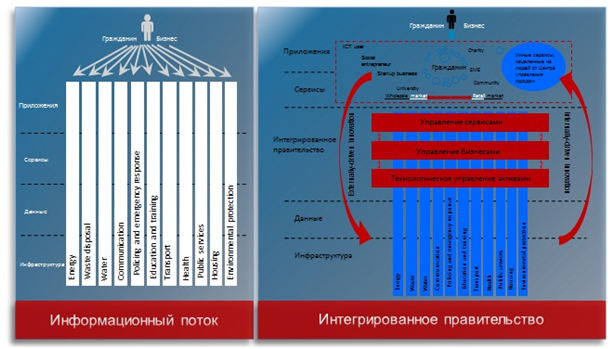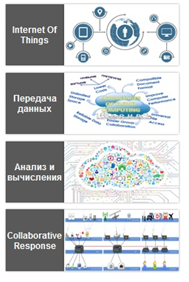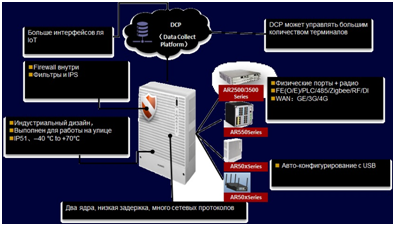Smart Cities, or Smart Cities = Happy Citizens

“You said that the city is powerful, but here everyone is weak ...”
- The city is an evil power. The strong come, become weak, the city takes power ... So you disappeared!
k / f "Brother"
We live in an amazing time. The time when it is realized what the fiction writers of the past decades talked about.
There is nothing unusual for us in “smart phone”, “smart vacuum cleaner”, “smart car”, “smart home”: smartphones and robot vacuum cleaners have become an integral part of our everyday life, residential building automation systems are becoming more and more popular development of unmanned vehicles.
The process of “smart-izatsii” everything and all of us around like a snowball who is picking up and gaining speed, increasing in volume. And with a high degree of confidence we can say that the next link in this chain will be the “smart city”, because almost all large agglomerations somehow think about automating the processes of urban management.
I think it's time to disassemble the topic on the shelves :)
')
Fairy-tale city, dream city
What is a "smart city", or, in the language of Shakespeare, Smart city? In fact, it is a universal integrated information support system that performs two main functions:
- provides key information to all levels of the city executive;
- provides feedback interfaces through which the executive can influence certain areas of city life that fall within its area of responsibility.
What is its use?
Firstly, the implementation of this concept unambiguously improves the quality of life of the population of the region, or, as it has now become fashionable to call it, life quality experience.
Secondly, it is reducing the cost of operating the infrastructure by automating the routine processes of urban management and creating means for objective monitoring of the work of urban services. In the current tough economic conditions, accompanied by a reduction in the amount of money, including in the housing and utilities sector, the optimization of current processes is perhaps the most popular solution.
But we break the beautiful packaging and see what is hidden under the label "Smart city".

The key link of the “smart city” is a certain operational center, which accumulates information from downstream systems and is a high-level aggregator of control actions.
The next level behind the center console is the level of specific areas of the urban economy , each of which has its own tasks and its own performance indicators with its own specifics. And in this regard, each such area is controlled by a separate application. For example, an application for "smart management of urban lighting", which allows you to set a general policy of controlling light in a city from a central console and optimize electricity costs and operational support for lighting. Or a system of "smart housing management", which monitors the condition of different areas of housing and communal services and can effectively respond to failures in some of its parts, as well as predict potential problems based on the analysis of data collected from sensors (for example, there are pressure drop: most likely, a leakage occurred at some of the sites, and the control system is designed to help locate and repair the damage, until it caused an accident).
All these separate systems (“smart light”, “smart utilities”, “smart traffic management systems”, “smart buildings”, “smart medicine”, etc.) are combined into a single central city management console - a sort of “urban brain” , which processes the information received: filters, sorts, aggregates and analyzes. The results of this processing are displayed on a citywide dashboard, reflecting the current state of the urban systems, a kind of control panel of the city head.
If there are any problems on the central panel, then the responsible persons can go to a specific system of management of the urban economy area directly from the panel and quickly sort out the details of what is happening and take adequate measures.
City as a service
In addition to monitoring urban systems and communications, the “smart city” is intended to improve for the better one more key aspect of urban life - the process of interaction between the authorities and the citizen. If earlier each area of urban economy was practically sovereign and managed relatively independently of the others (with its own standards, rules, procedures), then the “smart city” in its ideal implementation should provide the citizen with access to urban services through a single interface, to which general rules of interaction with clear indicators of quality and clear principles of work. In fact, this should be the implementation of the “City as a Service” idea, which gives the citizen the fastest and most convenient way of reverse interaction with the city infrastructure. "Integrated City Government", if you will.

Technological basis
Naturally, a number of technologies and solutions built on the basis of these technologies are possible to realize this concept from a technical point of view.
There are four basic elements in the technological structure of the “smart city”, namely:
- The Internet of things , the technological concept of which allows you to collect the necessary information from the objects and provides feedback to them;
- data transmission infrastructure , connecting applications with urban infrastructure;
- data analysis systems , allowing to extract useful information from a large amount of data;
- A system of aggregation and data unification , designed to streamline and synchronize huge data streams.

On the functions of the Internet of Things and the data transmission infrastructure, everything is more or less clear, but let's say separately about the presence of data processing platforms in the described technological basis.
It is obvious that the information flow in the systems of the "smart city" is huge and most of the information is actually duplicated, if not at all, it is not valuable. And data management systems play an important role: you need to correctly filter and cluster data, analyze and identify dependencies — the accuracy of the forecast and the accuracy of the response to the events that occur depend on it.
It would probably be fair to say that it is in these systems that the “mind of the smart city”, its “brain center” is concluded. And of course, a “smart city” is impossible without “smart people” - experts with a sufficient level of knowledge and skills for effective use of systems.
Attention, question!
We declare a break. Break on the rubric "Minute tricky questions." And the winner of the rubric today is the question “What is the basis for the hypothesis about the growing popularity of the“ smart city ”technology in the near future?”.
Thanks for asking. To date, there are clearly visible two global processes that are conducive to the spread of "smart cities".
The first of these is the growth of the urban population, with all the ensuing consequences. Today, more than 60% of the world's population lives in cities, and the trend for increasing the number of people in cities persists. For example, Moscow in terms of population is about three in Finland and about one and a half Czech Republic. At the same time, cities today create up to 70% of the gross world product, that is, in other words, up to 70% of the global economy is located in cities. Effectively managing such a huge farm without the use of high-tech tools is hardly possible. Therefore, today all large agglomerations are engaged in the implementation of the concept of Smart city. With different levels of readiness, there are examples of projects for building “smart cities” in all parts of the world, without exception.
The second process , perhaps even more important than the first, is the search for new sources of income in the next stage of technological development. Essentially, the introduction of a “smart city” is a big and profitable business. According to the classic BCG matrix (Boston Consulting Group), the development of the niche of “smart cities” is the introduction of a new “cash cow” to the market, which in the next few years will bring greater profits to the IT industry.

According to various estimates, by 2020 this market will be about one and a half trillion dollars. Moreover, the monetization of the "smart city" can go a variety of ways: there is no clear model by which the market operates. However, whatever one may say, one and a half trillion is a lot of money, and many people want to fight for it.
What are we waiting for ?!
With all the prospects of the solution, there are a number of reasons that impede the explosive development of “smart cities”. And Huawei is interested in overcoming these obstacles, because we see the future in the development of “smart cities”.
One of these reasons is the legacy of old systems with scattered data interfaces and old protocols, which are unclear how to integrate with each other. Such networks are slow, have many security problems and a whole bunch of flaws. And there are two solutions: either to cut out old systems and change them to new ones (but this is expensive and not always possible), or invent some kind of “magic piece of hardware” that will “fuck!” And collect the necessary data from heterogeneous interfaces, normalize them and transmit on the upstream platform.
Huawei went the second way. We have developed a universal gateway with a large number of wired and wireless interfaces, which performs the work of collecting and normalizing data from heterogeneous sources. At the current level of technological development without such a universal gateway, building an infrastructure for data collection in a “smart city” is comparable to a miracle. Either the network will be very complex and repeatedly redundant, or it will not collect all the necessary data.
So, what is the universal gateway from Huawei? In fact, this is the infrastructure basis of the network in the "smart city" - IoT-router, made in the industrial building and designed to work on the street, protected from the effects of adverse weather conditions.
The key concept here is IoT. This gateway integrates support for special industrial data communication interfaces (PLC, DI / DO, etc.), which are typical for SCADA systems rather than for telecommunications infrastructure. In addition, it implements a full stack of standard network protocols and firewall systems (a firewall is built in), so you can say without a twinge of conscience that this is a full-fledged router.
Deploying the network infrastructure of a “smart city” on the basis of such gateways is becoming a fairly typical and understandable task.

Another reason, which is a “stopper” for the development of “smart cities”, is the absence of a platform capable of working with really big data. The information flow of a “smart city” is very demanding on the performance of the systems that process this information.
Huawei can respond to this problem with Fusion Insight.
Fusion Insight is based on Hadoop, based on the Fusion Sphere cloud platform (OpenStack), the Huawei OceanStor storage system and X86-based computers.
We see great prospects for the development of "smart cities" technologies, growth in market volumes. That is why part of the development of Huawei in the near future will be aimed at supporting the popularization of Smart City technologies and technical support for the development of these technologies.
Source: https://habr.com/ru/post/323382/
All Articles